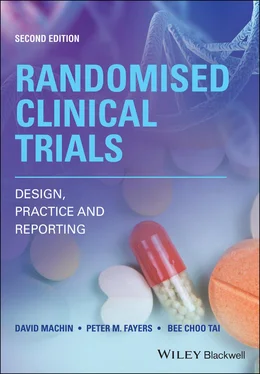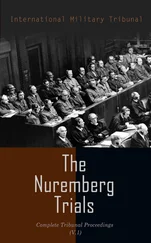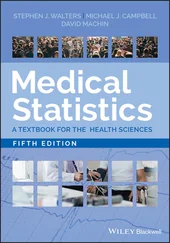– have participated in this trial during a previous admission
– are an elective surgical patient with a planned post‐operative admission to ICU
– are an elective surgical patient admitted more than 4 days before surgery
– sleep at night in a chair
– weigh >22 stones/140 Kg (upper weight limit for overlay mattress)
aTable 1 referred to here is similar to that of Figure 4.2in the next chapter.
In addition to the Exclusion Criteria, in the PRESSURE (2000) protocol, there were rather complex Inclusion Criteria as three general types of patients were to be included. These patients were those having an admission to one of the designated hospital wards, and who were also one of the following three types: (i) Acute, (ii) Elective with existing pressure sore or with reduced mobility, and (iii) Elective with neither a pressure sore nor with reduced mobility.
In the past, protocols tended to be restrictive about the patients admitted to trials and would focus on good‐prognosis patients. Modern trials increasingly adopt the perspective that patients are eligible provided the clinician regards all the options for treatment within the protocol as potentially suitable for the patient under consideration, and provided the clinician acknowledges that it is objectively unclear as to which option is preferable. Thus, fewer eligibility criteria now specify an upper age limit, but are more likely to emphasise that the patient should be fit enough to tolerate side effects and toxicity.
There are two aspects of the randomisation process that need to be described in the protocol. One is the structural features of the design while the other is the more procedural aspects of how patients will be randomised and hence allocated to a specific intervention. However, as we will discuss in Chapter 5, there is a difficulty in that if full details of a block based or other restricted randomisation schemes are made explicit in the protocol itself then the objectivity of the randomisation process may be compromised. So, we advise that such details are held in a confidential memo by the statistical team which is securely stored in the trial office files and, if need be, shared with the approving authorities but not with the clinical members of the protocol team until trial recruitment is complete.
Although Protocol AHCC01 (1997) referred in the statistical methods to a 2 : 1 : 2 randomisation between placebo (P), tamoxifen 60/mg/day (TMX60) and TMX120 no reference to ‘randomisation in blocks’ was made. Nevertheless, the eventual trial publication of Chow, Tai, Tan, et al . (2002) stated:
Randomization was performed in balanced blocks of 5, stratified by center, and corresponding to P, TMX60, and TMX120 in the respective ratios of 2 : 1 : 2.
In contrast to randomised blocks, the PRESSURE (2000) trial used a minimisation method (see Chapter 5) with the four factors recruiting centre, skin condition, clinical specialty of the admitting hospital ward, and whether an acute or elective admission.
Just as we have suggested that it is desirable not to reveal the block size, the precise amount of randomness set in a minimisation method should not be revealed within the protocol itself, but should be documented in a separate memo by the statistical team.
Example 3.14 Protocol PRESSURE (2000) Section 7.2: Pressure‐relieving support surfaces: a randomised evaluation
7.2 Mattress Allocation Method
Allocation to treatment will be by minimisation and with respect to the factors listed in Table 4.
Table 4 Minimisation factors
| Factor |
Levels |
|
| Centre |
× 8 |
As Section 6 a |
| Skin condition |
× 2 |
No pressure sore |
|
Existing pressure sore |
| Ward specialty |
× 3 |
Vascular |
| Orthopaedic |
| Elderly care |
| Admission type |
× 2 |
Acute |
| Elective |
a Section 6 of the protocol named the eight participating centres.
Whatever the design features of the randomisation process the protocol also has to address the method by which this is put into operation. This may range from a relatively unsophisticated telephone call or interchange of fax messages, to a web or even a voice‐based response system. Thus, the SQOLP01 (1999) protocol used a telephone‐based randomisation system the details of which we give below while a more recent EXPEL (2016) trial described by Kim, Chen, Tay, et al . (2017) opts for a web‐based.
Example 3.15 Protocol SQOLP01 (1999, Section 7): Comparison of steroid with cyclosporine for the topical treatment of oral lichen planus
7. Randomisation
After the potential OLP case has been confirmed according to the eligibility criteria and informed consent has been obtained, the patient should be randomised.
| To randomise a patient telephone |
| NMRC CLINICAL TRIALS & EPIDEMIOLOGY RESEARCH UNIT Tel: (65) 220‐1292, Fax: (65) 220‐1485Monday–Friday: 0830 to 1730, Saturday: 0830 to 1230 |
Some brief details will be collected for identification purposes and the caller will be informed of the result of randomisation and at the same time the patient will be assigned a protocol Trial Number.
Example 3.16 Protocol EXPEL (2016): Peritoneal lavage after curative gastrectomy
Enrolment and randomisation
Having obtained informed written consent, potential subjects will then undergo surgery. If the patients are confirmed to have cT3 or cT4 disease and are amendable to radical gastrectomy with curative intent, they will be formally enrolled into the study and undergo randomisation. Study participants will be randomised to EIPL arm or standard arm based on random permuted blocks with varying block size of four and six, assuming equal allocation between treatment arms. The randomisation is stratified according to individual study site. A web‐based randomisation programme ( https://rand.scri.edu.sg/) will be utilised to facilitate randomisation. The treatment code will be disclosed to the surgeon only at the end of gastrectomy. EIPL or standard lavage will then be performed according to the treatment code. The abdomen will then be closed as per standard.
The method of obtaining the randomisation that is chosen will depend on circumstances but the trend is now towards more automated systems. However, this trend does not preclude simpler – yet reliable approaches that are likely to be more viable for trials of modest size. The SQCP01 (2006) protocol for management of clefts of the secondary palate in infants provided for both a telephone‐ and a web‐based randomisation option.
The use of sealed envelopes by the clinical teams, as opposed to contacting a trials office remotely, is not regarded as an optimal method of allocation and should be avoided if at all possible. Whenever employed a clear justification for this is required. In the case of the investigators concerned with SQGL02 (1999) the nature of AACG, with its sudden onset and devastating consequences, provides the rationale.
Example 3.17 Protocol SQGL02 (1999): Brimonidine as a neuroprotective agent in acute angle‐closure glaucoma (AACG)
Procedure for randomisation
Due to the acute condition of AACG, sealed envelopes will be used for randomising the patients who will be more likely to be presented to the clinician after office hours.
3.9 Assessment and data collection
Читать дальше












